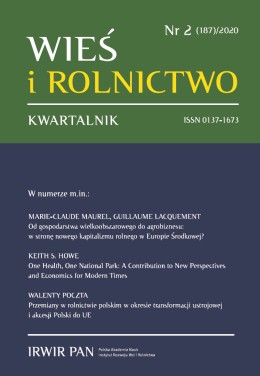From the Large-Scale Farming to Agribusiness: Towards New Agricultural Capitalism in Central Europe?
DOI:
https://doi.org/10.53098/wir022020/01Keywords:
post-collectivist agriculture, agro-holding, financialisation of agriculture, Central EuropeAbstract
In the context of agro-holdings with strong vertical integration, the development of corporate farming is shaping a new agricultural geography in Central Europe. Product of a singular history, the large farm was used as a base to the penetration of capitalism in agriculture and the balance of power which specify it. It is the economic, and even more political, modalities of capital accumulation in its various components that account for the growing grip of agribusiness over land as well as on the production machinery. The purpose of this article is to examine the economic logic behind its expansion in postcollectivist agriculture in Central Europe.
References
Atlas (2019). Atlas de la PAC. Chiffres et enjeux de la Politique Agricole Commune, wyd. 2. Paris: Heinrich-Böll-Stiftung.
Bański J. (2011). Changes in agricultural land ownership in Poland in the period of the market economy. Agricultural Economics, 57 (2), 93–101. DOI: https://doi.org/10.17221/18/2010-AGRICECON
Bartůšková J., Homolka J. (2009). Analysis of land-law relations development in the Czech Republic after 1989 in the legal and economic context. Agricultural Economics, 55 (5), 250–256. DOI: https://doi.org/10.17221/33/2009-AGRICECON
Bundesministerium für Ernährung und Landwirtschaft (2017). Daten und Fakten, Land-, Forst- und Ernährungswirtschaft mit Fischerei und Wein- und Gartenbau. www.bmel.de/SharedDocs/Downloads/Broschueren/DatenundFakten.pdf?__blob= (dostęp: marzec 2020).
Ciaian P. i in. (2009). The capitalisation of area payments into farmland rents: Micro evidence from the new EU member states. EERI Research Paper Series, 4, 1–26.
Ciaian P. i in. (2012). Rental market regulations for agricultural land in EU member states and candidate countries. Factor Markets. Working Paper, 15, 1–23.
Ciaian P., Drabik D., Falkowski J., Kancs A. (2017). New regulations governing land sales in Central and Eastern Europe: Imposing restrictions via particularized institutions, Joint Research Centre, European Commission.
Colin J.P. (2014). La concentration fonciere par la tenure inversée (reverse tenancy). Études rurales, 194, 203–218. DOI: https://doi.org/10.4000/etudesrurales.10194
Eddie S.M. (2008). Landownership in Eastern Germany before the Great War: A Quantitative Analysis. Oxford–New York: Oxford University Press. DOI: https://doi.org/10.1093/acprof:oso/9780198201663.001.0001
Eurostat (2018). Agriculture, forestry and fishery statistics. https://ec.europa.eu/eurostat/documents/3217494/9455154/KS-FK-18-001-EN-N.pdf/a9ddd7db-c40c-48c9-8ed5-a8a90f4faa3f (dostęp: grudzień 2019).
Gerke J. (2003). Zur Transformation der Landwirtschaft in Ostdeutschland, eine Zwischenbilanz, Der Kritische Agrarbericht, 54–57.
Halamska M. (1995). La difficile reconversion de l´agriculture étatique en Pologne. Revue d´etudes comparatives Est-Ouest, 26 (3), 91–118. DOI: https://doi.org/10.3406/receo.1995.2741
Halamska M. (1998). Dekolektywizacja rolnictwa w Europie Środkowej i jej społeczne konsekwencje. Warszawa: Polska Akademia Nauk, Instytut Rozwoju Wsi i Rolnictwa.
Halamska M. (2016). The evolution of family farms in Poland: Present time and the weight of the past. Eastern European Countryside, 22 (1), 27–51. DOI: https://doi.org/10.1515/eec-2016-0002
Halamska M., Maurel M.C. (2010). Decollectivisation of agriculture and reshaping of agrarian structure in Central Europe. Przegląd Socjologiczny, 59 (2), 29–56.
Lacquement G. (1996). La décollectivisation dans les nouveaux Länder allemands: acteurs et territoires face au changement de modele agricole. Paris: L’Harmattan.
Lacquement G. (2011). Lire et analyser la transformation post-socialiste dans les territoires ruraux d’Allemagne orientale. Lyon: Mémoire de HDR, Université Lumiere. http://tel.archives-ouvertes.fr/tel-00650927/fr/ (dostęp: styczeń 2020).
Lazíková J., Bandlerová A. (2015). New rules for acquisition of agricultural land – Case of Slovakia. EU Agrarian Law, 4 (1), 18–27. DOI: https://doi.org/10.1515/eual-2015-0003
Maurel M.-C. (1994). La Transition post-collectiviste. Mutations agraires en Europe centrale. Paris: L’Harmattan.
Maurel M.C. (2012). Large farms in Central Europe: An unchanging spatio-temporal feature?, Études rurales, 190, 25–47. https://www.cairn-int.info/abstract-E_ETRU_190_0025--large-farms-in-central-europe-an.htm (dostęp: marzec 2017). DOI: https://doi.org/10.4000/etudesrurales.9664
Maurel M.C. (2019). Acces limité aux terres par les nouvelles lois foncieres en Europe centrale et balte. La revue de l’Académie d’agriculture, 17, 39–44.
Maurel M.-C., Halamska M., Lamarche H. (2003). Le repli paysan. Trajectoires de l’apresommunisme en Pologne. Paris: L’Harmattan.
Purseigle F. (2012). Les agricultures de firme. Organisations et financiarisation (vol. 1). Études rurales, 190.
Purseigle F. (2019). De nouvelles formes d’entreprises agricoles pour de nouveaux défis. La revue de l’Académie d’agriculture, 18, 34–37.
Purseigle F., Chouquer G. (2013). Les agricultures de firme 2. Délocalisation et évictions, (vol. 2), Introduction, « Les territoires saisis par la firme ». Études rurales, 191, 9–18. DOI: https://doi.org/10.4000/etudesrurales.9747
Purseigle F., Nguyen G., Blanc P. (2017). Le nouveau capitalisme agricole. De la ferme a la firme. Paris: Presses de Sciences Po. DOI: https://doi.org/10.3917/scpo.purse.2017.01.0013
Roszkowski W. (1995). Land Reforms in East Central Europe after World War One. Warszawa: ISP PAN.
Schwarcz P., Bandlerová A., Schwarczová L. (2013). Selected issues of the agricultural land market in the Slovak Republic. Journal of Central European Agriculture, 14 (3), 1102–1115. DOI: https://doi.org/10.5513/JCEA01/14.3.1314
Swain N. (2013). Agriculture ‘East of the Elbe’ and the Common Agricultural Policy. Sociologia Ruralis, 53 (3), 369–389. DOI: https://doi.org/10.1111/soru.12016
Swinnen J., Van Herck K., Vranken L. (2016). The diversity of land markets and regulations in Europe, and (some of) its causes. Journal of Development Studies, 52 (2), 186–205. DOI: https://doi.org/10.1080/00220388.2015.1060318
Szabo R. (2013). Hungarian land-grabbing: Family farmers vs. politically backed oligarchs. Green European Journal, 5, 26–30. https://www.greeneuropeanjournal.eu/hungarian-land-grabbing-family-farmers-vs-politically-backed-oligarchs/ (dostęp: grudzień 2019).
Źródła internetowe:
https://ec.europa.eu/eurostat/statistics-explained/index.php?title=Small_and_large_farms_in_the_EU_-_statistics_from_the_farm_structure_survey&oldid=406560 (dostęp: styczeń 2020).
https://ec.europa.eu/eurostat/statistics-explained/images/7/7f/Share_of_the_labour_force_directly_working_on_very_large_farms_in_economic_terms%2C_by_type_of_labour%2C_2013_%28%25_of_total_labour_force_in_AWUs%29.png (dostęp: styczeń 2020).
https://multinationales.org/Andrej-Babis-l-oligarque-de-l-agrochimie-devenu-Premeirministretcheque (dostęp: luty 2020).
https://www.largescaleagriculture.com/home/news-details/restructuring-of-czech-large-scale-farms-will-continue-ladislav-jelinek/ (dostęp: marzec 2020).
https://www.bonafarmcsoport.hu/en/bonafarm-group/ (dostęp: marzec 2020).











